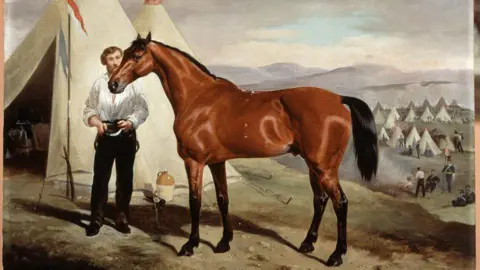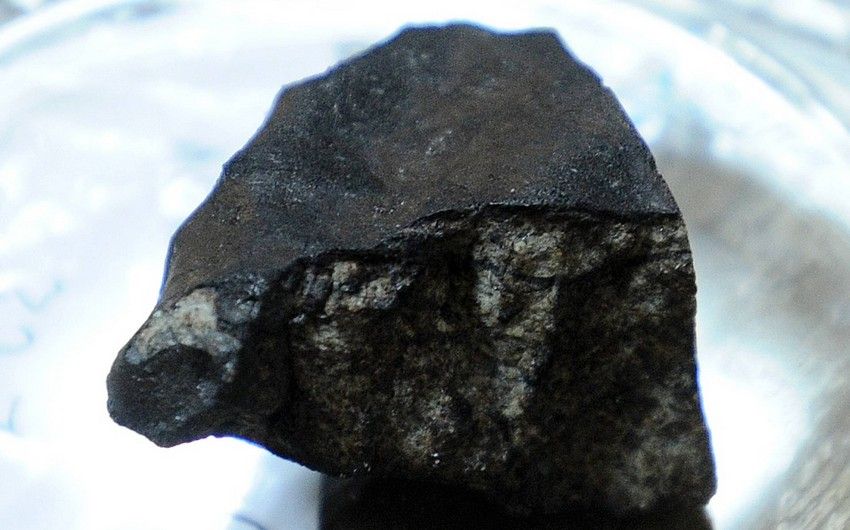Lucy Owen & Oscar Edwards
BBC News

Martin Clunes' new book details real-life tales of animal heroism, loyalty and companionship
Actor Martin Clunes has praised a Welsh war horse who survived the Charge of the Light Brigade in the Crimean War, describing the blind sacrifice of animals in battle as "heartbreaking".
Sir Briggs, a champion steeplechaser who belonged to Newport landowner Lord Tredegar, was transported to Russia in the 1850s for battle.
The Doc Martin and Men Behaving Badly star feels sad many horses went into battle with no idea of what awaited them, he told Lucy Owen on BBC Radio Wales.
His new book details real-life tales of animal heroism, loyalty and companionship - and how Sir Briggs even went on to win races again after surviving the war against huge odds.
Animal-lover Clunes has kept horses for many years - and even took giant Clydesdale Bruce to meet hospice patients to cheer them up.
"We've given horses medals for gallantry, put up statues in their honour and venerated them for their service," he said.
"I feel sad when I think of all the horses who went into battle with no idea of what awaited them."
While Sir Briggs was accustomed to jumping fences and ditches in races, his fate was sealed when his owner, Godfrey Morgan or Lord Tredegar, took command of a squadron during the Crimean War.
He was then transported to Russia ready for battle - and rode in the famous Charge of the Light Brigade in 1854.

Martin Clunes with his first horse Chester
It was part of the Battle of Balaclava when British light cavalry took on Russian forces, and is remembered in detail partly because of Alfred Lord Tennyson’s popular poem of the same name.
In it, the poet praised the bravery of the men as they rode into the “valley of death".
Due to a miscommunication of orders, on 25 October 1854, the Light Brigade, which included the 17th Lancers led by Captain Morgan on Sir Briggs, was ordered to attack, and charged directly into Russian artillery fire.
Captain Morgan is quoted by the Royal Lancers and Nottinghamshire Yeomanry Museum describing the battle, as saying: "Our pace increased amidst the round shot and shell, whistling and cracking overhead.
"Horses and men dropped by scores every yard."
Describing riding Sir Briggs during the charge, he added: "Digging my spurs in my horse's sides he went at it as he has often gone at the big fences in Monmouthshire."
Despite reaching Russian positions, the Light Brigade had to retreat, making their way back through the "Valley of Death" before reaching safety.
The British Army Museum described it as "one of Britain’s most spectacular military disasters".
Advertisement

Welsh war horse Sir Briggs survived the Charge of the Light Brigade
Captain Morgan had another challenge for Sir Briggs before returning home.
"They survived the Charge of the Light Brigade, which not a lot of people did," Clunes said.
"Sir Briggs got a little scratch... but before coming home he [Captain Morgan] entered him in a quick steeplechase out in France, which he won."
Sir Briggs returned home and lived a long and happy retirement, before he died aged 28.
He is buried in the grounds of Tredegar House in Newport, the Morgan family home, where his memorial stone can be seen to this day.
Advertisement
 National Trust Cymru
National Trust CymruAn exact replica of Sir Briggs has been hand-woven by willow artist Sarah Hatton to commemorate the battle
Tredegar House, which is now run by the National Trust Cymru, has commemorated the 170th anniversary of the Charge of the Light Brigade.
More than 4,000 hand-made poppies were draped over an exact replica of Godfrey Sir Briggs.
The willow tribute commemorates the military past of those who have lived and worked at Tredegar House.
National Trust Cymru said it also "serves as a poignant reminder of the courage and sacrifice of all who have served their country".










